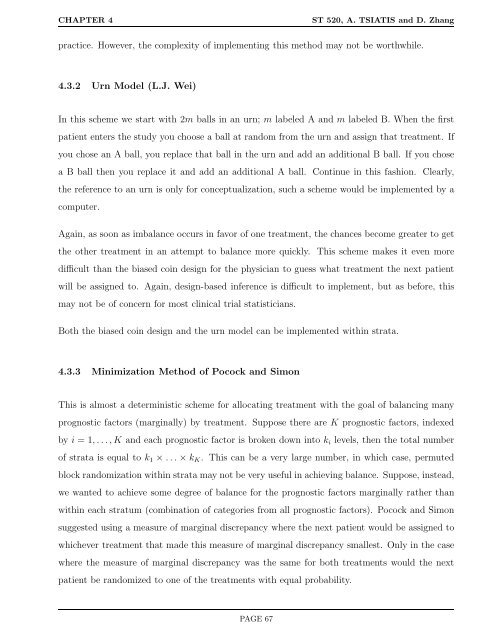ST 520 Statistical Principles of Clinical Trials - NCSU Statistics ...
ST 520 Statistical Principles of Clinical Trials - NCSU Statistics ...
ST 520 Statistical Principles of Clinical Trials - NCSU Statistics ...
You also want an ePaper? Increase the reach of your titles
YUMPU automatically turns print PDFs into web optimized ePapers that Google loves.
CHAPTER 4 <strong>ST</strong> <strong>520</strong>, A. TSIATIS and D. Zhang<br />
practice. However, the complexity <strong>of</strong> implementing this method may not be worthwhile.<br />
4.3.2 Urn Model (L.J. Wei)<br />
In this scheme we start with 2m balls in an urn; m labeled A and m labeled B. When the first<br />
patient enters the study you choose a ball at random from the urn and assign that treatment. If<br />
you chose an A ball, you replace that ball in the urn and add an additional B ball. If you chose<br />
a B ball then you replace it and add an additional A ball. Continue in this fashion. Clearly,<br />
the reference to an urn is only for conceptualization, such a scheme would be implemented by a<br />
computer.<br />
Again, as soon as imbalance occurs in favor <strong>of</strong> one treatment, the chances become greater to get<br />
the other treatment in an attempt to balance more quickly. This scheme makes it even more<br />
difficult than the biased coin design for the physician to guess what treatment the next patient<br />
will be assigned to. Again, design-based inference is difficult to implement, but as before, this<br />
may not be <strong>of</strong> concern for most clinical trial statisticians.<br />
Both the biased coin design and the urn model can be implemented within strata.<br />
4.3.3 Minimization Method <strong>of</strong> Pocock and Simon<br />
This is almost a deterministic scheme for allocating treatment with the goal <strong>of</strong> balancing many<br />
prognostic factors (marginally) by treatment. Suppose there are K prognostic factors, indexed<br />
by i = 1, . . ., K and each prognostic factor is broken down into ki levels, then the total number<br />
<strong>of</strong> strata is equal to k1 × . . . × kK. This can be a very large number, in which case, permuted<br />
block randomization within strata may not be very useful in achieving balance. Suppose, instead,<br />
we wanted to achieve some degree <strong>of</strong> balance for the prognostic factors marginally rather than<br />
within each stratum (combination <strong>of</strong> categories from all prognostic factors). Pocock and Simon<br />
suggested using a measure <strong>of</strong> marginal discrepancy where the next patient would be assigned to<br />
whichever treatment that made this measure <strong>of</strong> marginal discrepancy smallest. Only in the case<br />
where the measure <strong>of</strong> marginal discrepancy was the same for both treatments would the next<br />
patient be randomized to one <strong>of</strong> the treatments with equal probability.<br />
PAGE 67
















